The foundation is the basis of any structure, to which increased requirements are imposed. The stability of the entire building, durability depends on the correctness of its arrangement. For the construction of the support, different materials are used. The brick foundation must meet certain requirements; before starting work, site preparation is required.
Factors affecting a brick foundation
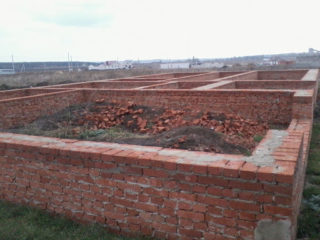
The choice and operation of a brick base is influenced by the resistance of the soil, the degree of pressure of the building on it. In addition, the forces of soil swelling are of great importance.
Additional factors:
- Groundwater level. It can be determined by the way of drilling wells at different points of the site. Depending on what material the house will be built from, their depth ranges from 5-10 m.
- The level of soil freezing.
- The purpose of the structure, its design features. This takes into account the thickness of the walls, the presence of a basement, a garage, ancillary buildings.
Do not forget about the characteristics of the material chosen for the foundation.
Existing design bases
The foundation for a brick house is of different types. The choice of a specific base depends on the type of building and the characteristics of the soil.
Columnar
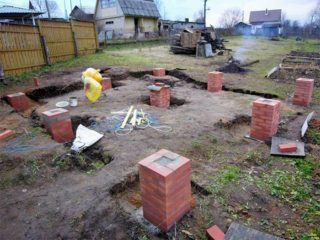
The columnar base is suitable for structures with a small mass: summer houses, baths, open verandas and terraces. Supports are installed in the corners of the structure, as well as at the intersection of the walls. Additional posts are mounted around the entire perimeter of the building. The step between them is 2 m.
The laying of a foundation of this type is carried out in square pits, the size of which is 1x1 m. Before installing the brick, a sand cushion is laid at the bottom, which is compacted.
Tape
If the structure will have a lot of weight, it is better to use the tape version of the brick base. It is suitable for covered terraces, houses with outbuildings. For arranging a brick strip foundation, a trench is prepared, the width of which is 1 m.
For the foundation to be strong and geometrically correct, the construction of formwork is required. The work uses not only bricks, but also concrete mortar. Its mortar must be uniform along the entire length of the foundation. Bricks must be laid with bandaging of the seams. Reinforcement is laid between every two rows of material. Steel bars or mesh are used. These elements will make the foundation more durable and resistant to external negative influences.
The slab foundation provides for the use of a monolithic element under the entire building. In this case, the basement of the base is made of brick. The concrete slab can be buried in the ground or lie on its surface.
Choosing a brick for the foundation
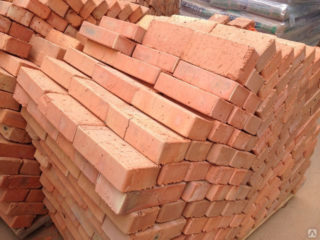
The strength of the base depends on the quality of the material. There are such types of products:
- Silicate (white). Such a brick is acceptable for the construction of the above-ground part - the basement. The shallow depth of groundwater is becoming a limitation for use.
- Clay (red). The material has high strength. You can choose for the construction of the underground part of the structure.This is dictated by its good resistance to soil moisture and compression.
The choice of the product is influenced by the possible load on 1 cm² of the area. Good properties are possessed by material of grade 150 and higher. You also need to take into account the level of frost resistance of the brick. This figure should not be less than the F-35. The moisture absorption coefficient is important. The optimal level is from 6 to 16%. The elements can be standard, modular or thickened in size.
When choosing a foundation brick, you need to pay attention to its quality, which is determined by visual inspection of each product:
- uneven color indicates a violation of the production technology of the material;
- if the edges are uneven, and the element itself crumbles easily, it has already been used;
- bricks should not quickly absorb moisture, as this will destroy them faster.
A stronger construction can be obtained from products with corrugated sides. They have the best adhesion to concrete mortar.
Necessary tools for the job
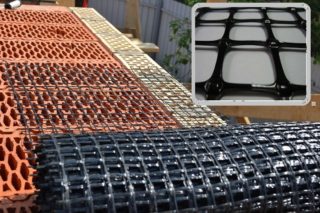
For the manufacture of a red brick foundation, in addition to the main material, concrete mortar and a reinforcing mesh are required to strengthen the structure. Separately, sand and crushed stone is needed for mounting the pillow at the bottom of the trench. From masonry tools you will need:
- Master OK;
- cord, jointing;
- hammer pickaxe;
- shovel;
- construction and hydro level, plumb;
- pegs for marking the territory;
- steel reinforcement.
You can prepare the grout by hand, but it is better to use a concrete mixer.
Stages of building a brick foundation
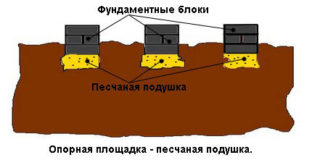
To build a brick foundation with your own hands, no special knowledge is required. It is necessary to observe the technology of work and correctly calculate the amount of building material.
Sequencing:
- Site marking. It is carried out according to the plan. Stakes and cord are used.
- Trench preparation. If the foundation is strip, the pit should be slightly wider than the estimated thickness of the structure, for the convenience of work and the organization of waterproofing.
- Sand pillow making. After excavation of the earth, sand is poured at the bottom of the trench, which is moistened and rammed. The layer of the pillow is 15 cm. It must be even, which is checked using a building level.
- Installation of waterproofing. It is better to use several layers of roofing material. It is laid on the bottom and walls of the trench.
- Formwork installation. After installation, a cushion is made of concrete mortar, the height of which is 10 cm. It will improve the bearing capacity of the base.
- Bricklaying. First, the corners are mounted, and then the rows with the dressing of the seams. Then take a break for 2-3 weeks. This is necessary for the curing of the solution.
- Dumping. After the concrete hardens, the formwork is removed, the remaining cavities are covered with construction waste, crushed stone, gravel or broken brick.
So that precipitation does not harm the foundation, it is necessary to beat off around the entire perimeter of the structure. Before erecting the box at home, a layer of waterproofing is laid on the upper part of the basement.
Brick is suitable for the construction of structures of small number of storeys and mass: garages, outbuildings, baths. It should be borne in mind that the pressure of the box on the ground should be minimal. The design is used on stable dry soils.
Pros and cons of brick foundation
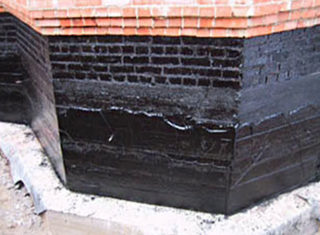
Any building structure has advantages and disadvantages. Pros of a brick base:
- safety for the environment and humans;
- high speed of installation work, the ability to perform them yourself;
- relatively small price;
- good level of thermal insulation;
- ease of masonry repair.
However, there are certain disadvantages: the porosity of the structure requires the use of a good waterproofing material.If the procedure is performed poorly, moisture gets inside the brick, which contributes to its freezing and destruction. The disadvantage is the complexity of the work.








